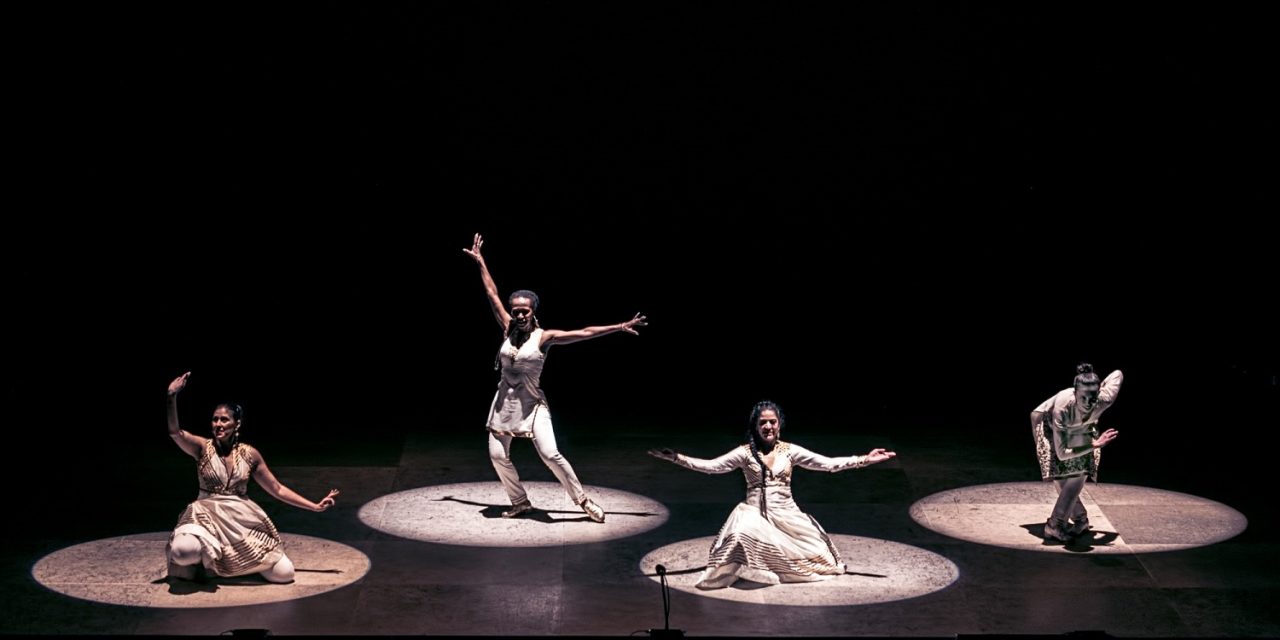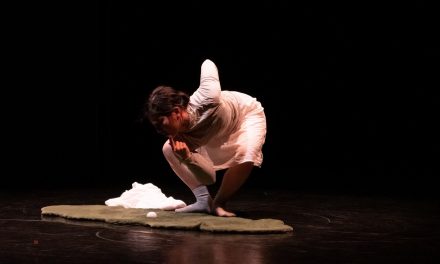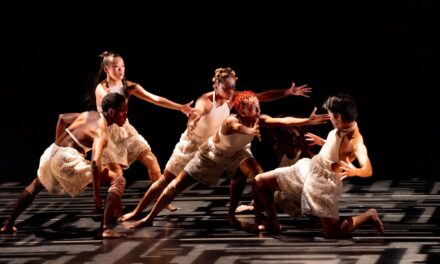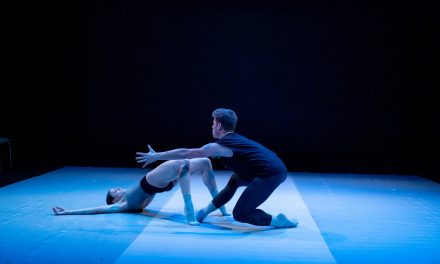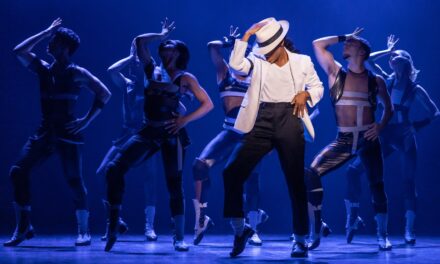The Eli & Edythe Broad Stage, located within the Santa Monica College Performing Arts Center was the venue for Indian Kathak dance and American tap dance to come together for an evening of rhythmic magic. SPEAK: TAP & KATHAK UNITE indeed felt like the east and west cultures were conversing across continents via music and dance. Indian Kathak dance artists along with American Tap artists sparred with, jammed with and beautifully blended with Kathak and Jazz musicians. It was a performance that brought the Thursday night audience to its feet.
Kathak is native to northern India and it is one of the six classical Indian dance forms. It originated within the Hindu temples as a storytelling device to portray the epic tales contained within the Hindu scriptures. Nomadic Kathaks later carried these dances to other parts of India, adding facial expressions and elements of mime. Over time, Kathak became a strong dance tradition with features of both Hindu and Muslim cultures.
Tap dance is an original American art form which has its roots in the fusing together of several ethnic percussive dances, including African tribal dances, English clog dancing and Irish jigs. It began in the mid-1800s during the rise of minstrel shows. What tap and Kathak dance have in common is the frequent use of syncopated rhythms with the dancer’s feet generally close to the floor. Tap dancers use medal taps on the toe and heel of their shoes, while Kathak dancers perform bare foot with Ghungroos or Ghungrus (rows of small bells) worn around their ankles.
Act I opened with a short solo by Sitarist Jayanta Banerjee, joined in by Satyaprakash Mishra on the Tabla and Valbhav Mankad with Vocals and Harmonium. The section was entitled Maya, a call to the warrior goddess Durga and Kali, the goddess of creative destruction, and was performed by Kathak dancer Rina Mehto and Tap virtuoso Michelle Dorrance. These two artists combined the traditional rhythmic elements of each dance form in a work created in the “rare 9.5 cycle”, a rhythm that I would guess is not common in western music.
Michelle Dorrance is an award winning artist and the Artistic Director of the New York based company Dorrance Dance. She is a familiar figure in LA as her company has performed several times in the area. She is a master of Tap and an intense performer. Rina Mehta is the founding artist of the Leela Dance Collect which brings together artists from around the world “to advance a collective vision of Kathak”. Her performance style is more subdued, which oddly complimented Dorrance’s fast moving and often high stepping style.
Act II featured Satyaprakash Mishra on the Tabla working his rhythmic splendor with those of Kathak dancer Rachna Nivas in Thaat, a more traditional Kathak movement and rhythmic work. Rivas trained with legendary master Pandit Chitresh Das and she is also a founding artist of the Leela Dance Collective. Nivas has a more presentational style, incorporating eye and head movements not seen in the previous work. Thaat was filled with sudden stops, curtsy-like drops to the floor and very fluid arm movements that suddenly became sharp slices to freeze Nivas into place, her head continuing to move gently side to side. The solo was rather lengthy, but Nivas kept her audience’s attention through her facial expressions, charm and the use of multiple in-place spins.
Sumbry-Edwards is a two-time Bessie Award winner who has performed on Broadway and in film, and who spent 11 years as Michael Jackson’s tap instructor. Kirwani featured her and Dorrance, two exceptional artists, in a dynamic and rhythmic world wind dance to a classical music piece composed in the Indian music scale called Raag Kirwani. All three Indian musicians performed, but the dancers worked primarily with Tabla player Mishra. They moved in unison and separately as they visualized, echoed and jammed with this breathtaking percussion artist. Mishra’s fingers moved over the Tabla with lighting speed while Sumbry-Edwards and Dorrance proved why they are major figures in dance.
Nirupana was the reverse configuration of Kirwani. Here, Rachna Nivas and Rina Mehta performed Kathak to jazz music in a work based on Kathak Yoga, a technique using the different layers of polyrhythms. They opened with vocal rhythms, working in unity and opposition. Staaf, Lake and Miller soon joined in and it was intriguing how these two styles gelled and complimented one another. There was a wonderful moment where both women performed standing totally on their heels, tapping out extremely fast rhythms and moving backwards. Standing on one’s heels is in of itself difficult. I am by no means an authority on Kathak dance, but I was not as impressed by Nivas and Mehta’s performance.
Dormeshia Sumbry-Edwards glowed in Tap Solo, a dance that showcased her exquisite talents. She performed to the jazz standard Tenderly, written in 1946 and first made famous by singer Sarah Vaughan. Sumbry-Edwards remained statuesque while executing rapid fire rhythms. Performed beautifully by Staaf, Lake and Miller, Sumbry-Edwards wove her magic within this beautiful and familiar classic.
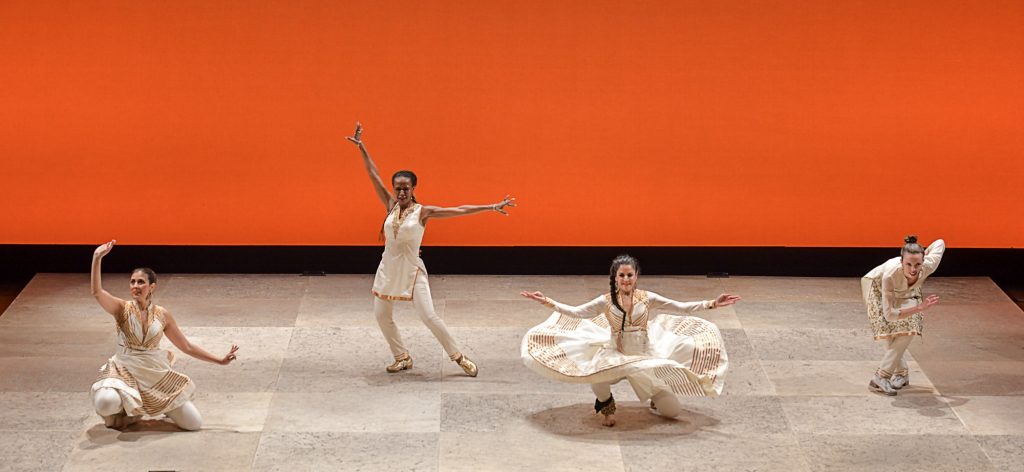
SPEAK in rehearsal -L-to-R-Rina Mehta, Dormeshia Sumbry-Edwards, Rachna Nivas, Michelle Dorrance. Photo-Credit: ShaunAlexander.net
Act III brought forth the talents of all six musicians “speaking” musically across the stage in a work entitled Chalan. The genres shifted between cultures before dueling musically and all six musicians were clearing having a wonderful time doing so. Each musician displayed their talents with a brief solo, but the highlights of this section were provided by Tabla player Mishra, Bass player Lake and Percussionist Miller. It was truly a celebration of musical talents.
The evening concluded with the entire cast performing One, a perfect title to describe two cultures fusing together to create a distinctive art experience. The four dancers moved together, in a rhythmically swirling circle and then spun off into solos and duets that featured each artist.
The costume theme was white with gold trim; Nivas and Mehta in dresses while Sumbry-Edwards and Dorrance wore long kurta tops over pants, and gold painted tap shoes. The lighting design by David Robertson also utilized the gold and white hues, and timed expertly with different rhythmic moments throughout the evening. There was no intermission, but the transitions between pieces were seamless to aid in creating the feel of unity.
Featured photo: SPEAK – (L to R) Rina Mehta, Dormeshia Sumbry-Edwards, Rachna Nivas, Michelle-Dorrance. Photo-Credit: ShaunAlexander.net.
SPEAK: TAP & KATHAK UNITE continues at The Broad Stage through tonight. For information and tickets, click here.
To view the LA Dance Chronicle Calendar of performances, click here.

